|
|
 |

List
Sites | Join
| Prev
| Next

Please make your mark on My Guestbook
Map!!
It would be great for us all just to see
how far we can get around the world and we'll make the journey together.( SAFE JOURNEY ) to all old and new friends...
Take care and see you all soon :0) xxx
|
 |
|

Britain's Union Flag - usually wrongly called the Union Jack - records in its name and fusion of three different emblems,
the growth of one kingdom out of the successive union of three crowns.
The original English flag was white and bore
the plain red cross of
St. George, the country's patron saint. He was a 3rd century Christian soldier who had preferred
death by beheading to denouncing his faith. The red cross recalled his martyrdom by Roman hands at Lydda, in Palestine. When
the English Knights joined in the Crusades, they identified themselves by the saint's symbol. On their return, the religious
emblem eventually became the national flag.
The
choice of St. George as a patron has been linked with the tradition that during the Crusades, the saint's apparition rescued
the English from the fury of their Moslem foes. His sudden appearance on the battlefield threw the Mohammedans into confusion
and flight. Thus the English recognized and acknowledged him as their patron. King Edward III adopted his name as a battle
cry, and his emblem became the English flag.
Queen Elizabeth ll
Supported by her husband Prince Philip she has adapted the monarchy to the modern age
introducing more informality by walkabouts and TV appearances but without losing dignity.
Buckingham Palace
Buckingham Palace
has served as the official London residence of Britains sovereigns since 1837. Today it is The Queen's official residence.
Although in use for the many official events and receptions held by The Queen.
The State Rooms of the Palace are open to visitors during the Annual Summer Opening in August and September.
If you visit Buckingham Palace you
can also watch The Changing of the Guards which is held on the out side of the gates.
The ceremony
The ceremony lasts 40 minutes and takes place inside the palace railings,
which means you can watch it from outside. The Queen's Guard, accompanied by a band, leaves Wellington Barracks at 1127 and
march via Birdcage Walk to the Palace. Changing the Guard is cancelled in very wet weather.
| Big Ben & London Eye !! |
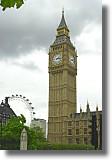
|
Big Ben and London Eye
Big Ben, the 320 foot high Clock Tower is named after the largest bell, weighing over 13 tons, and was cast
in 1858 at the Whitechapel Bell Foundry in East London. To this day one of the largest bells they have ever cast. Each clock
face is over 7m in diameter.
Standing
proud in Londons Jubilee Gardens,
Paris has the Eiffel Tower, New York the Empire State, and now London has the British
Airways London Eye - an extraordinary symbol for an extraordinary city. The world's largest observation wheel offers a spectacular
way to take in over 55 of London's most famous landmarks in just 30 minutes! Combine your flight on the Eye with a 45 minute
circular cruise on the Thames, this is a focal point of the Nations celebration of the New Century.

Tower of London
One
of the most famous fortified buildings in the world. Begun in 1078 by William the Conqueror, the Tower has been a palace,
prison, treasury, arsenal and even a zoo! Today the Tower houses the priceless Crown Jewels. Also on view are the Medieval
Palace, the infamous Bloody Tower and over 90 inscriptions made by prisoners in the Beauchamp Tower.
Home to the Crown Jewels and over 900 years
of history.
____________________________________________________________________________________________________________

The history of the Scottish saltire may be
summarised as follows:
c.1180: The first use of the St. Andrew's Cross in Scotland - but as a religious, not a national,
emblem (the seal of the Chapter of St. Andrew's cathedral).
1286: The first appearance of the figure of St. Andrew on his
cross as a national emblem (the seal of the guardians of Scotland).
1385: The first evidence of the use of the cross, without
the saint, as a national emblem - but this was on soldiers' uniforms raher than as a flag (an act of the Scottish parliament).
Late
15th Century: Several references to flags with a St. Andrew's Cross, but it is not known whether it was the only emblem on
such flags.
1503: The first certain use of a plain St. Andrew's Cross flag - but the field was red, not blue (the Vienna
Book of Hours).
1542: The first certain illustration of the St. Andrew's Cross on a blue field as we have it today (armorial
of Sir David Lindsay).
It would therefore be better to say that the flag dated from the 16th Century.
| Loch Ness !! |
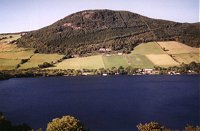
|
Loch Ness
Loch Ness is 23 Miles long, 1 Mile wide and averages 700 feet deep, with some parts going
down to 754 feet. Visibility is almost zero, due to the peat content of the water.
Is it just a rumour or is theyre really a beast lurking in the deep, dark waters of the Scottish
lake? 60 years ago, hundreds claim to have witnessed the Loch Ness Monster and nicknamed her 'Nessie' (Will it ever be Proved)????
| The Museum of Scotland !! |
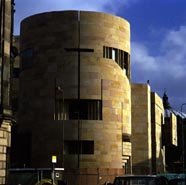
|
The Museum of Scotland
A striking new landmark in Edinburgh's historic Old
Town.
The Museum of Scotland
presents for the first time the history of Scotland - its land, its people and their achievements - through the rich national
collections.
The Museum is in Chambers Street, located
in the heart of Edinburgh, ten minutes walk from the main railway station (Waverley Station) and five minutes from the Royal
Mile. When visitors enter, the first sight is the magnificent Main Hall.
| Kilt !! |

|
|
Scottish
Dress ( The Kilt ).
The saying goes "The Kilt is
seen as the national dress of Scotland and that "a man in a kilt is a man and a half." Kilts are distinctive,
romantic and very colourful. The two pictures below are just a couple of different 'Tartans' that you can get in the form
of a kilt, also pictured below..
The use of tartan in Scotland predates the kilt as tartan appeared as a design before the small kilt was invented. The first
recorded use of the modern kilt was in 1575, but the use of the tartan predates this significantly.
The Tartan Kilt has long been the most recognizable cultural tradition of
the Highland Scots. However it was developed in the nineteenth century, not by Scottish Highlanders, but by the Nobles of
England and Scotland. |
| Tartan Material !! |

|
Plaid is simply the name of the material, which
is used for making kilts. It isn't the name of the pattern on the material; this is called "Tartan" (patterned woollen cloth).
____________________________________________________________________________________________________________

The DDraig Goch (red dragon) flag is the national flag
of Wales, and has been officially recognised as such since the 1950s. By the way, the white-over-green field is the livery
colours of the Tudors, the Welsh dynasty that once sat on the English throne.
Roy Stilling
Conventional wisdom is that the "draco" standards of the
Romans were adopted by the Britons, probably as a metal (possibly real gold) head with a windsock type of body made of silk.
In the mouth was a whistling type device that would make sounds as it was waved with vigor. Supposedly used by King Arthur,
certainly used by the Wessex lords in the 700s, the emblem has been used by Britons right up to the present time. Y ddraig
goch ddyry cychwyn! (The Red Dragon Gives Impetus!)
Dave Martucci
"Y ddraig goch ddyry cychwyn!" does have another meaning,
which is why, according to an article in the current Flagmaster, it lasted for only six years as part of an "honourable augmentation"
to the Welsh Emblem.
| St David's Cathedral !! |

|
St David's Cathedral
St David is thought to have been born near the present town of St
David's. The ruins of a small chapel dedicated to his mother, none, may be seen near St. David's Cathedral. David became
the Abbot of St David's and died on 1st March 589. A.D. Rhygyfarch, a monk at Llanbadarn Fawr near Aberystwyth, wrote
an account of his life towards the end of the 11th century.
Many
miracles were attributed to him. One miracle often recounted is that once when Dewi was preaching to a crowd at Llandewi Brefi
those on the outer edges could not hear, so he spread a handkerchief on the ground, and stood on it to preach, whereupon the
ground rose underneath him, and all could hear. He was buried in what is today St David's Cathedral in Pembrokeshire.
His holiness was such that medieval pilgrims equated two pilgrimages to St David's were worth one pilgrimage to Rome - a great
saving in journeying at that time! Fifty churches in South Wales alone bear his name.
March 1st, St
David's Day, is now the traditional day of the Welsh. March 1 is the date given by Rhygyfarch for the death of Dewi
Sant, was celebrated as a religious festival up until the Protestant Reformation of the 16th century. In the 18th century
it became a national festival among the Welsh, and continues as such to this day.
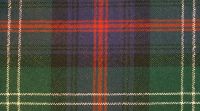
The Welsh wore fashion akin to kilts two thousand years ago, probably with a form of
leather trousers or leggings wrapped around with rope. This form of dress remained a feature of Welsh society confirmed by
the discovery of a 9th Century stone carving depicting a man wearing a kilt. This evolved through the centuries into the woollen
garment we are familiar with today. Initially this would have been made from raw coarse wool and undyed.

Colours of the welish Tartan
When people
think of the tartan now, most think of the very colourful pattern of the cloth of the Scottish highlands. But originally the
word "tartan" described the way the thread was woven to make the cloth: each thread passed over two threads then under two
threads, and so on.... (Indeed, the original "tartan' was a very light, woollen material which couldn't really keep the wearer
warm). This gives tartan its distinctive appearance. Unlike a conventional check, there is always a square where the two colours
of thread cross creating a speckled blend of the two colours .
____________________________________________________________________________________________________________

The oldest known reference
to the use of the three colours (green, white and orange) as a nationalist emblem dates from September 1830 when tricolour
cockades were worn at a meeting held to celebrate the French revolution of that year - a revolution that restored the use
of the French tricolour. The colours were also used in the same period for rosettes and badges, and on the banners of trade
guilds.
There is also
one reference to the use of a flag 'striped with orange and green alternately'. However, the earliest attested use of a tricolour
flag was in 1848 when the Young Ireland movement under the influence of another French revolution adopted it. Speeches
made at that time by the Young Ireland leader Thomas Francis Meagher suggest that it was regarded as an innovation and not
as the revival of an older flag.
Dublin
Dublin - the capital of Ireland and one of Europe's most vibrant cities. The whole region is buzzing, riding high on the
crest of an economic boom and its effects are to be seen everywhere, from the frantic nightlife to a skyline filled with cranes. It's
the home to over a quarter of the Ireland's population, almost one million in all, Dublin is a youthful, vibrant and dynamic
city.

City Hall in Dublin
Erected between 1769 and 1779, and formerly the Royal
Exchange. It is a square building in Corinthian style, with three fronts of Portland stone. Since 1852, however it has been
the centre of the municipal government.
Erected between 1769 and 1779, and formerly the Royal Exchange.
It is a square building in Corinthian style, with three fronts of Portland stone. Since 1852, however it has been the centre
of the municipal government. The interior is designed as a circle within a square, with fluted columns supporting a dome shaped
roof over the central hall. The building contains many items of interest, including 102 royal charters and the mace and sword
of the city.
Irish
Peatlands;
Peat is a soil that is made up of the
partially rotted remains of dead plants that have accumulated on top of each other in waterlogged places for thousands of
years. It consists of Sphagnum moss along with the roots, leaves, flowers and seeds of heathers, grasses and sedges. Occasionally
the trunks and roots of trees such as Scots pine, oak, birch and yew are also present. These are three main types of peat
lands in Ireland.
Blanket Bogs,
which consist of a carpet of peat extending over large areas
of land. Their nutrient supply is obtained from rainfall. There are two types:
(1) Atlantic blanket bogs which are found
in low-lying (below 200 m) areas of the western counties.
(2) Mountain blanket bogs which are found in mountainous areas
(above 200 m) throughout the country.
Raised Bogs, dome-shaped bogs that have developed in former lake basins in the
midland counties. Their nutrient supply is obtained from rainfall.
Fens,
flat bogs which are found around lake margins and in waterlogged areas where there is a supply of mineral-rich
waters. (Raised bogs develop on top of fens when the mineral-rich water supply is cut off.)

Coole Pard.....Gort Country
Coole Park, now a nature reserve,
was the home of Lady Augusta Gregory, dramatist and co-founder with Edward Martyn and W. B. Yeats of the Abbey Theatre. Attractions
include exhibitions, tearooms, nature trails, walks, and the famous "autograph tree", a Lakeland a turlough.
|
 |
|
|
 |
|
|
 |
|
|
|
In
this area i'll be doing about some of the locations around my near by Towns, Cities and also something about the different
seasides Eg ; Blackpool, Skegness etc...
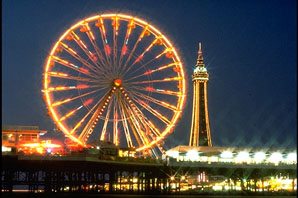
Blackpool's most electrifying night is when
the Lights are switched on and the ceremony, a real razzmatazz showcase, has been performed by all the biggest names. Stars
of Coronation Street, maestro of the musicals Sir Andrew Lloyd Webber, even Kermit the Frog have had the crowds cheering as
fireworks hit the sky and the eye dazzling display gets under way.
Holidaymakers have tripped the Lights
fantastic since 1879 when just electric arc lamps bathed the Promenade in what was described as artificial sunshine; we now
know it as The Golden Mile. This is where people come from all over the country to travel up the promenade to see all the
wonderful light displays e.g.; Eddie Stobart, Coronation street characters, Rings, Film Stars and thats just some of whats
in store. The Golden Mile even offers seaside favourites like hamburgers, chips, ice cream and candyfloss. A place where silly
hats and saucy T-shirts are the order of the day. The Golden Mile is also the slot machine capital of Britain where giant
leisure centres are interspersed with the latest video technology. Discos, cabaret spots and exhibitions are all to be found
on Blackpool's famous Golden Mile. Along the latest additions to the Mile is the 6 million pound Sea Life Centre with its
thrilling 'shark tunnel'. Do the Golden Mile on foot to savour all the sights, sounds and smells. Then see it again from a
tram or one of the fleet of horse-drawn carriages!
| The Pepsi Max.. |

|
Blackpool
Pleasure Beach is Britain's top free tourist attraction welcoming over 7 million visitors annually. There's something for
everyone, with over 145 rides and attractions including one of the greatest selections of rollercoasters anywhere on the planet.
Whether you're 2 or 102, there's something for every age group. There's Beaver Creek, Children's Theme Park, through to the
extreme white knuckle experiences of the Pepsi Max Big One, to leisurely cruises around the River Caves or a trip on the world's
first commercial monorail, making Blackpool Pleasure Beach the perfect fun destination for everyone.
The true me
|
|
|
 |

